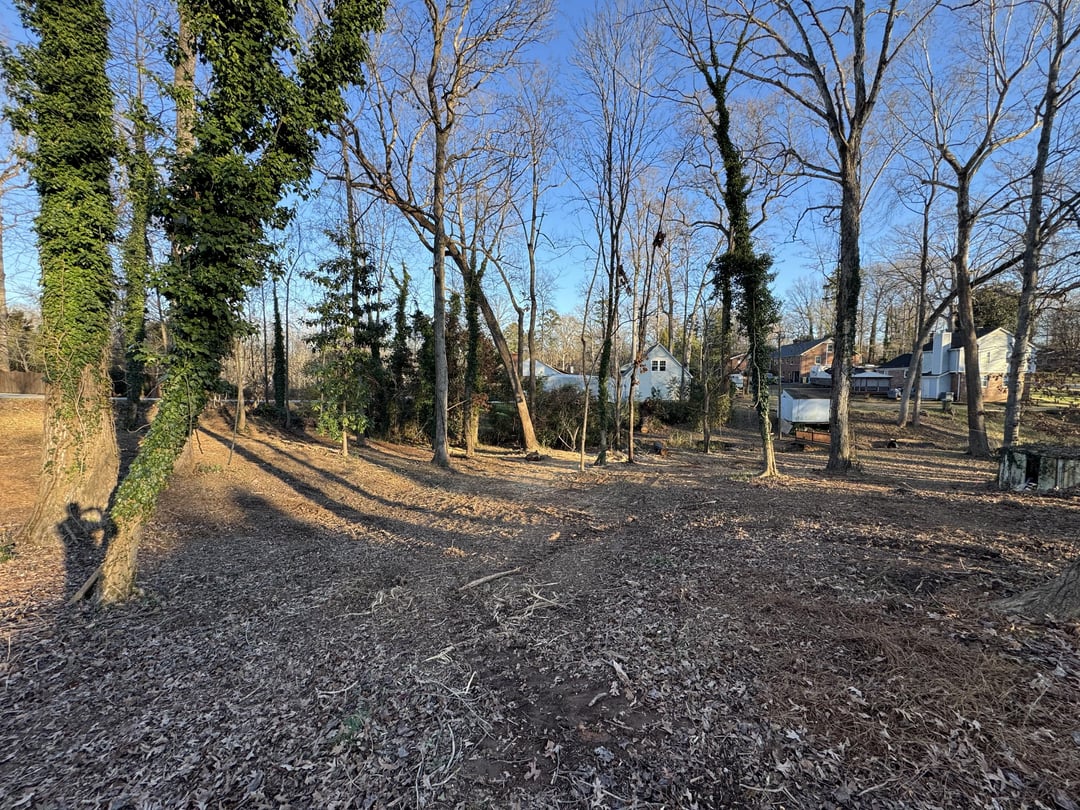


The good news! Just bought this house on an entire acre. The bad news, the previous owners let the yard overgrow, for decades.
Where do I start? I just had a brush hog come through and grind everything up. Yard is currently a mixture of dead leaves, pine straw, mulch, and top soil.
Gameplan was to plant some annual rye in the short term while I figure out how I want to landscape.
by Bluebaru2


5 Comments
Mulching leaves into the lawn is tremendously beneficial for several reasons:
– provides organic matter to the soil (good for nutrient and moisture retention, alleviates compaction, and improves drainage in the long term)
– provides the lawn with many nutrients that are difficult and expensive to supply otherwise… Particularly, but not limited to, all of the micronutrients. (Trees are just way better at taking up nutrients than grasses are)
– is an incredibly effective form of pre-emergent weed control… Extremely effective for preventing broadleaf weeds, and can even prevent/reduce future poa annua and crabgrass.
[According to MSU](https://www.canr.msu.edu/resources/mulch_leaves_into_turf_for_a_smart_lawn), up to 6 inches of leaves can be mulched into a lawn at one time. That number partially depends on your mower performance… But even in the worst case scenarios, it might just mean going over the leaves multiple times. (Still quicker than raking or bagging)
Tips for mulching leaves effectively:
– go into fall at a high mowing height… Its too late to change that now, but it helps.
– use an actual mulching blade (most new push mowers come equipped with mulching blades. Mulching blades are the ones with the curved cutting edge and the blade has curved surfaces on top to generate uplift)
– plug the side discharge chute. Push mowers usually have a flap that’s easily closed. Riding mowers often require a seperate accessory to plug the chute.
– don’t let the leaves pile up. Most of the time, weekly will be enough, but if you have windy days, you might need to get out there an extra time or more.
– do it when the leaves are mostly dry. It can actually help if they’re a LITTLE wet… But dry is certainly better than too wet.
– Yes you can safely mulch pine needles and walnut leaves. It’s a myth that pine needles acidify soil. There’s insufficient proof that juglone from walnut trees is actually allelopathic… Regardless, spread out over a lawn, that wouldn’t be a concern.
– if you notice clumps of matted leaves… Knock them loose. I usually just kick them, but a rake or blower works too.
The classic argument against mulching is “they’ll smother the grass”… Simply put, if you smother the grass, you’re doing it wrong (especially that last step)… Unless you’ve got a lot of poa trivialis or poa annua… Mulching leaves can actually smother those… In which case, that’s usually a good thing… But even then, they’ll still fill back in next year.
Note: Don’t mulch leaves if you plan on dormant seeding… The weed prevention thing I mentioned above also PROBABLY applies to ungerminated grass seed… Probably. Inconsistent data on that one.
*I am a bot, and this action was performed automatically. Please [contact the moderators of this subreddit](/message/compose/?to=/r/lawncare) if you have any questions or concerns.*
Congratulations on the new house. I’m sure others will chime in with their thoughts but the only thing I would do right now is kill the ivy on your trees. I would then work on house related stuff until spring. In spring, I would then use a light meter to determine how much sunlight each area receives. That’s going to dictate what type of grass you’ll be able to grow. I would also record some videos of the area when it is raining so you know how the water flows since grading might need to occur. Doing so can help you determine what cost and time commitment would be needed to have the lawn that you want. Did your neighbors with similar lots let Mother Nature take over as well?
Mulch in existing leaf drop like automod suggests. Pick up larger sticks / branches.
I think you need to take some of those trees down. At least the one that seems to already be leaning on the other. They probably all need pruning. You want to get an arborist / tree service out there.
I’d take down the shed if it’s on the property and replace if needed.
Make a plan on paper for what you want to do. Concrete patio sidewalks maybe. Grill set. Gas line? Sinks?
Grading/drainage/irrigation if necessary. Like the guy above said. Make sure water is going away from the house and not pooling.
Congrats on the house!
Since it appears you’re sort of starting with a blank slate for the yard, you might want to start with grading. Does water run away from your house? Any large low spots? Generally flat or lots of bumpy areas in the yard? Too many trees in some areas?
Second, sounds like you have great base of organic mix in your soil. But probably have a ton of weeds to get under control. Going to be a challenge to do that and over seed in spring. Not sure exactly where you are located, what type of lawn you are looking for (natural, manicured, wam season or col season grass, etc). You’ll probably want to figure out some of that to decide next steps. If you have a lot of other priorities in your new home, might be easiest to just overseed seed with a high quality seed plus starter fertilizer in spring and worry about weeds later.
Start by cutting those ivy vines of your trees and let the ivy loosen their grip from the tree bark before pulling them down with a rope from a safe distance 6 months later .Your trees will thank you.